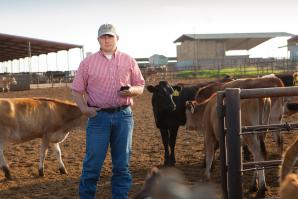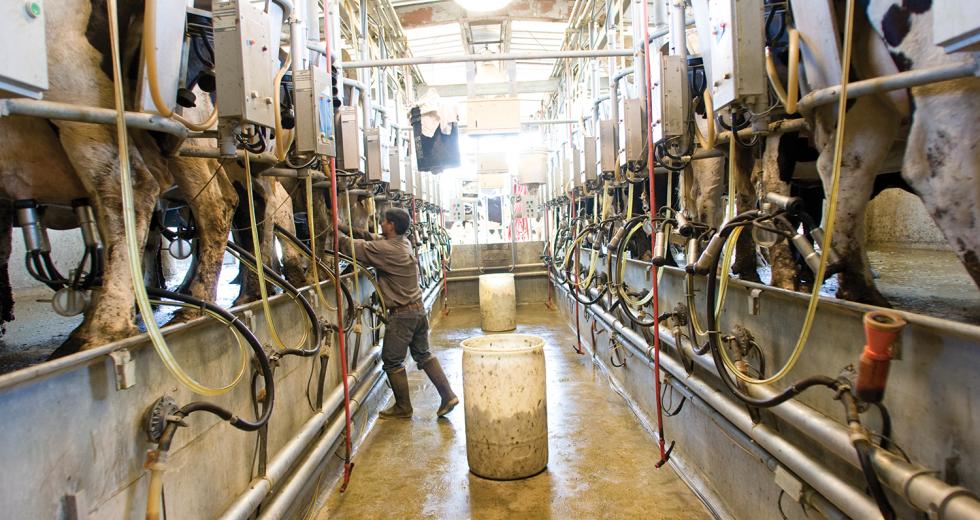Wearing coveralls and galoshes caked in manure and mud, a father and son attach suction devices to the teats of ailing cows.
It’s just past 6 a.m., and the sun has barely crested the horizon. The father is Tony Duarte, a grizzled 63-year-old man with no filter on his speech. His son, Justin, is 36. He is a big guy at 6 feet 3 inches, and he wears a long reddish beard. In one shed, they’re tending to the sick and gimpy cows while a worker in a bigger shed milks two dozen healthy cows from the 525-cow herd. At dawn, on this 160-acre dairy farm in Elk Grove, these men are wide awake and hard at work.
This is no job for the dainty or the undedicated: It smells like hay and dung, flies buzz, and the cows squirt and squat excrement whenever and wherever they please.
“They will defecate at any time,” Justin says, “so you got to make sure you watch out for any friendly fire.”
But this is nothing compared to the current economic mess the Duarte family and the dairy farmers of America find themselves in.
In November 2007, U.S. milk prices soared to record highs, reaching their second-highest levels in 2008. To capitalize on high demand and rising exports, milk producers expanded production. Everything was flowing smoothly … that is, until mid-2008 when global economic turmoil turned everything on its ear.
The price of corn spiked as Wall Street players placed bets on grain that produced energy-efficient ethanol. That affected farmers because corn is such a pivotal part of cow feed. Energy prices and gas prices shot up. At the same time, imports rose, forcing domestic demand for dairy products to drop, and wholesale prices crashed when farmers had so much leftover milk and extra cows. In the past nine months, America’s dairy industry has gone sour.
“Times are grim at this point,” says Lynne McBride, legislative director for the California Dairy Campaign and the executive director of the California Farmers Union. “As far as I know, there’s really no end in sight. Even if dairy prices improve, people have so much ground to make up.”
On the more than 60,000 dairy farms in the U.S., farmers have felt the squeeze of the recession. According to the California Dairy Campaign, the average cost of production for California dairy producers is $18 per hundredweight, or 100 pounds. For the first half of this year, producers were getting only about $10 per hundredweight.
U.S. dairy farmers are struggling with mounting losses as milk prices are down more than 30 percent from last year, well below operating costs for many farmers. In some cases, milk prices have dropped so low that farmers can’t afford to feed the animals. On top of rising feed prices, people don’t eat out as much. Farmers have had to adjust feed rations, forgo equipment upgrades and get rid of cows just to make ends meet.
No state has been hit as hard as California. Dairy is the state’s largest commodity, and the volatile milk prices have been eroding the lifestyle of many dairy workers in California.
“California was hit first and hit the hardest,” McBride says. “It’s really to a crisis point for producers throughout the state.”
The California Dairy Campaign and California Farmers Union created a resolution at the beginning of 2009. Proposed steps include implementing fair tariffs on unregulated imported dairy solids, mandating greater market transparency, establishing a milk inventory management program and updating the federal dairy product price-support program to more accurately reflect the cost of production.
The goal was to influence the key people who control milk pricing, specifically the price-support program. In this industry, government agencies, not market forces, dictate prices. The price-support program gives farmers a safety net, and if prices drop below that floor, the government will then purchase milk-derived products such as nonfat dry milk and cheddar cheese. Typically, the government then gives the surplus products away to schools, the military and foreign aid programs.
At the end of July, U.S. Agriculture Secretary Tom Vilsack gave farmers some long overdue good news: The price paid for powdered milk and cheese through the price-support program would increase for the first time in nearly three decades. That should increase the hundredweight price paid to farmers by at least $1.25. Although the increases will only be in place for the next three months, officials estimate it could boost dairy farmers’ revenue by $243 million throughout the United States.
“I was hoping that it would be a little stronger than where it wound up,” says Joaquin Contente, state president of the California Farmers Union, who has a farm south of Fresno. “But we do surely appreciate what he did. There’s a lot of pain in the countryside. A lot of these dairy farmers don’t know how they’re going to pay for the next load of hay.”
Contente and other farmers and advocacy groups have long been pushing for the secretary to raise the support price. So many producers, he adds, are reaching “the end of their rope.” Even farmers who capitalized on the organic milk craze some years ago have suffered.
“It provides a little bit of a squeeze where, a few years ago, you couldn’t get enough organic milk,” says Lynne Devereux, founding president of the California Artisan Cheese Guild. “Now people are saying, ‘I’ll just go with the cheap stuff.’”
But, she says, the volatility of milk prices has been a key incentive for dairy farmers to turn their milk into artisan cheese. Artisan cheese, contrary to mass-produced cheese, is manufactured by the hands of skilled cheese-makers. They use various techniques such as aging and ripening to give the cheeses more distinct textures and tastes. Farmstead cheese is one type of artisan cheese that producers make with milk from their own cows, sheep and goats.
These farmers have fared slightly better, she adds, because the larger retailers such as Costco still demand artisan cheese.
Tim Pedrozo would know. The third-generation dairy farmer runs a 45-cow farmstead cheese operation in Orland, and when the milk market started to spoil, he shifted the bulk of his production to artisan cheese.
“These tougher economic times have really shifted our focus to more on farm cheese production and more direct sales,” says Pedrozo, a member of the California Artisan Cheese Guild. “That’s really where we get our greatest return. How we’re able to really survive is making our farmstead cheese.”
A year ago, Pedrozo’s production was split down the middle between milk and cheese. But now, he says, cheese makes up 80 percent of his production while milk is down to 20 percent.
“Dairy producers are overregulated,” he says. “These regulations are strangling the existing dairy farmers. In the next couple years, if things don’t turn around, California does stand to lose probably 25 percent of the dairy [industry].”
In addition to producing more cheese, Pedrozo has also increased his efforts in direct sales. He goes out on weekends to farmers markets, meets with distributors and targets the consumers that tend to spend more money.
“That’s what we’re doing to try to stave off a bad situation,” he says. “It’s been tough. But we’ve actually been able to weather the storm OK.”
Indeed, it has been a nightmare for dairy farmers across the country. Many farms have gone belly up, and producers must now find other ways to make money in an economy that has crushed them.
Not the Duarte family. Justin Duarte says he refuses to leave.
“I’m not a quitter,” he says. “I’m gonna ride this thing till the wheels fall off.”
The family has been doing what it can to absorb the economic blows. The good news is they don’t have a lot of outstanding loans. They prepay for commodities, and if they don’t have the cash, they won’t buy it. The buildings and equipment have been paid off, but they’re losing $1,000 per cow per year. If things don’t change, they will have to borrow $525,000 from the bank to stay alive.
They’ve made adjustments here and there, cutting corners while being careful not to affect the product quality. For example, they added 18 extra plates to the cooling system to cool the milk faster so the ice machine wouldn’t have to use as much electricity. To remodel the milk barn, they bought used equipment from a farmer in Oregon who went out of business. They’ve even started buying cheaper semen from competitors, which he admits is a “crapshoot because you don’t know what you’re going to get.”
This isn’t always how the media portrays the industry, he says. “You turn on the TV, and you see happy cows in California up on a pasture,” he says. “I’m not looking to get rich. I’m not looking for a handout. I just want to take care of my cows and continue on.”
Duarte says he wouldn’t know what else to do if they lost the farm. He doesn’t have a four-year degree, he says; this is the life he knows, driving since he was 7, feeding since he was 9 and milking since 11. No video games. He was in the field before sunup and after sundown. And that’s the life he wants to give his children. He and his wife have two boys, ages 3 and 5, and a daughter on the way.
“There’s no better way to raise a family than on a dairy farm,” he says. “I’ve got a 160-acre playground here. At least I know they will know how to work. They will run that shovel every which way.”
Up the road from the farm, in a one-story house, Justin’s mother, Antoinette, works around the clock to manage the money. She and her husband have put so much into the dairy farm since 1967 that it pains her to think that Duarte Dairy Inc. may cease with their generation. She recalls talking to Justin’s son, her grandson, recently. He loves life on the farm, especially the tractors and the big trucks.
“Grandma, I want to milk cows like my dad,” he told her one day. “That’s what I want to do when I grow up.”
“It’s not the choppers and big trucks that make the money to pay the bills,” she said to him. “The cows pay the bills.”
Then one afternoon in July, Antoinette was in the front yard getting ready to leave for a dairy meeting in Sacramento. Her grandson asked her where she was going; she told him.
Then he asked her, “Is it because of crappy milk prices grandma?”
She nodded.
“But I thought the cows are supposed to pay the bills,” the boy said.
“I know,” she told him. “But right now, they’re not.”
Recommended For You

Curd Your Enthusiasm
Cheesemaking in the Capital Region gets better with age
Tucked in the back of a local restaurant in downtown Winters is a nondescript room revealing an enticing view: floor-to-ceiling shelves packed with 10-pound wheels of cheese.

Reap, Sow, Tweet
Branding ag through social media
“Good morning, Sacramento! It’s a perfect day for a pig roast. Come out and join us,” hog farmer Perrin Clark tweeted on a long-awaited day in May.



